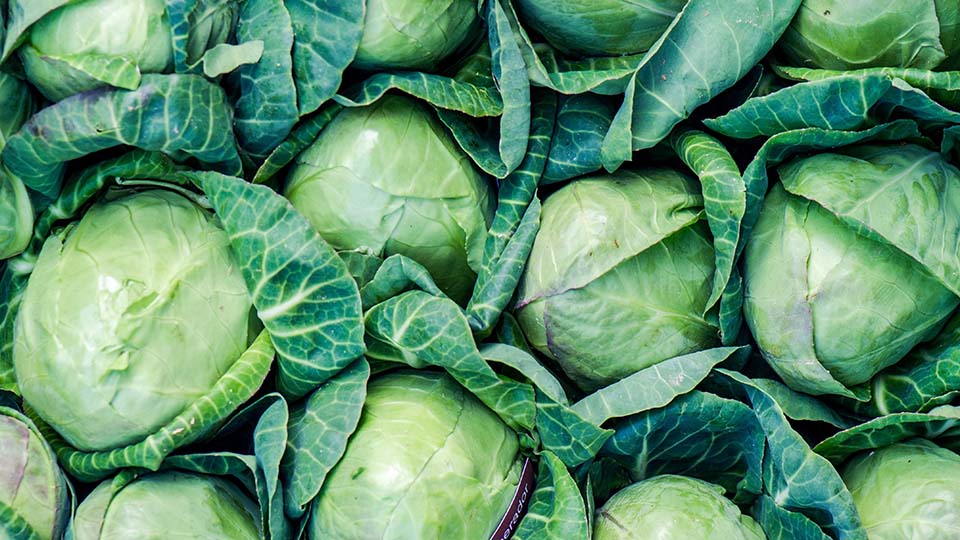How to Grow Cabbage in Your Garden

Cabbage is a cool season vegetable that prefers sunny locations and fertile, well-drained soil. Incorporate some organic matter and a complete fertilizer into the area before planting. Plant seeds ¼-½ inch deep, 2-3 weeks before the last frost in the spring. Thin seedlings or transplant cabbage 12-18 inches apart in the row with rows 2-3 feet apart. Avoid fertilization during head formation as this causes excessive leaf growth and head splitting. Irrigation should be deep and infrequent. The use of plastic or organic mulches helps conserve water and reduces weed growth. Control insects and diseases throughout the year. Harvest cabbage when the heads reach full size, but before they split open.
Recommended Cabbage Varieties
There are many good cabbage varieties for sale in local gardening outlets, on-line and through seed catalogs. Most grow well in Utah. Golden Acre (65 days), Ruby Ball (red; 55 days), Savoy Ace (80 days), and Danish Ball Head (100 days) have excellent production, eating quality, and storage potential.
How to Grow Cabbage
Soils
Cabbage prefers fertile, well-drained soil rich in organic matter for best growth. Most soils in Utah are suitable for cabbage production.
Soil Preparation
Before planting, determine fertilizer needs with a soil test and then follow the recommendations given with the test report. If fertilizer applications are warranted, work the fertilizer into the top 6 inches of soil. If you fertilize with compost, apply no more than 1 inch of well-composted organic matter per 100 square feet of garden area.
Plants
Cabbage can be grown from seed or transplants. Seeds should be planted ¼-½ inch deep and thinned to the final stand when plants have 3-4 true leaves. Plants removed at thinning can be transplanted to adjacent areas. Transplants are used to provide earlier harvest. Transplants should have 4-6 mature leaves and a well-developed root system before planting out. Generally 6-7 weeks are required to grow transplants to this size.
Planting and Spacing
Seeded or transplanted cabbage should be spaced 12-18 inches between plants in the row and rows 2-3 feet apart. Cabbage grows best when temperatures do not exceed 80°F and is not seriously damaged by temperatures down to 25°F. Transplants should be planted 2-3 weeks before the last frost free date for the growing area. Seeded cabbage may be planted at the same time. For fall maturing cabbage, select early maturing cultivars and plant 50-75 days before the anticipated maturity date. The maturity date should be about 1-2 weeks after the first fall frost. High temperatures reduce growth, decrease quality, and may cause internal tipburn to form.
Water
Water cabbage deeply and infrequently while trying to maintain even soil moisture. About 1-2 inches of water are required per week. Use drip irrigation if possible to conserve water. Applying mulch around the plant also helps conserve soil moisture and reduces weed growth. Moisture fluctuations during heading will cause maturing heads to split open.
Fertilization
Apply ½ cup per 10 feet of row of a nitrogen-based fertilizer (21-0-0) 4 weeks after transplanting or thinning to encourage plant growth. Avoid applying additional nitrogen after heads begin to form. High nitrogen levels at this time cause loose heads and splitting to occur. Place the fertilizer 6 inches to the side of the plants and irrigate it into the soil.
Mulches and Row Covers
Plastic mulches help conserve water, reduce weed growth and allow earlier planting and maturity, especially with transplants. Hot caps and fabric covers are used to protect seedlings and transplants from frosts. Fabric covers also protect young plants from insect pests. Apply organic mulches when temperatures increase above 80°F. Organic mulches such as grass clippings, straw, and shredded newspaper help cool the soil, reduce water stress and help control weeds.